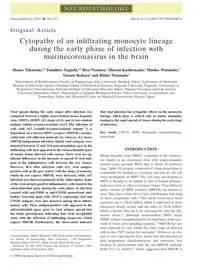
2010 Cytopathy of an infiltrating monocyte lineage during the early phase of infection with murinecoronavirus in the bra PDF
Preview 2010 Cytopathy of an infiltrating monocyte lineage during the early phase of infection with murinecoronavirus in the bra
Original Article neup_1082 361..371 Cytopathy of an infiltrating monocyte lineage during the early phase of infection with murinecoronavirus in the brain Hanae Takatsuki,1,2 Fumihiro Taguchi,3,4 Risa Nomura,1 Hiromi Kashiwazaki,1 Mariko Watanabe,5 Yuzuru Ikehara6 and Rihito Watanabe1 1Department of Bioinformatics, Faculty of Engineering, Soka University, Hachioji, Tokyo, 2Laboratory of Molecular Biology of Infectious Agents, Graduate School of Biomedical Sciences, Nagasaki University, Nagasaki, 3Laboratory of Respiratory Viral Diseases, National Institute of Infectious Diseases, Tokyo, 4Nippon Veterinary and Life Science University, Musashino, Tokyo, 5Department of Applied Biological Science, Tokyo University of Agriculture and Technology, Tokyo, and 6Research Center for Medical Glycoscience, Ibaraki, Japan Viral spread during the early stages after infection was compared between a highly neurovirulent mouse hepatitis virus (MHV), JHMV cl-2 strain (cl-2), and its low-virulent mutant, soluble-receptor-resistant (srr)7. The infection of cells with srr7 (soluble-receptor-resistant mutant 7) is dependent on a known MHV receptor (MHVR), carcino- embryonic cell adhesion molecule 1a, whereas cl-2 shows MHVR-independent infection. Initial viral antigens were detected between 12 and 24 h post-inoculation (p.i) in the infiltrating cells that appeared in the subarachnoidal space of mouse brains infected with viruses. There were no sig- nificant differences in the intensity or spread of viral anti- gens in the inflammatory cells between the two viruses. However, 48 h after infection with cl-2, viral antigen- positive cells in the grey matter with the shape of neurons, which do not express MHVR, were detected, while srr7 infection was observed primarily in the white matter. Some of the viral antigen-positive inflammatory cells found in the subarachnoidal space during the early phase of infection reacted with anti-F4/80 or anti-CD11b monoclonal anti- bodies. Syncytial giant cells (SGCs) expressing viral and CD11b antigens were also detected among these inflam- matory cells. These antigen-positive cells appeared in the subarachnoidal space prior to viral antigen spread into the brain parenchyma, indicating that viral encephalitis starts with the infection of infiltrating monocytes which express MHVR. Furthermore, the observation indicates that viral infection has cytopathic effects on the monocyte lineage, which plays a critical role in innate immunity, leading to the rapid spread of viruses during the early stage of infection. Key words: CD11b, JHM, meningitis, neuropathology, syncytium. INTRODUCTION Mouse hepatitis virus (MHV), a member of the coronavi- rus family, is an enveloped virus with single-stranded, positive-sense genomic RNA that is about 30 kilobases long.1 Spike (S) protein, composed of virion projections, is responsible for binding to a receptor and also for the cell entry mechanism of MHV. The cell entry mechanism of MHV is thought to be similar to that of human immuno- deficiency virus or other enveloped viruses.2 Four different splice variants of MHV receptor (MHVR) are known to exist. They have either two or four ectodomains with long or short cytoplasmic tails.3,4 Two allelic forms have been reported: one is CEACAM1a, which is expressed in most laboratory mouse strains, and the other is CEACAM1b, which is known thus far to be expressed by only the SJL mouse strain.5,6 Although neurovirulent MHV strain JHMV induces encephalomyelitis by infecting a wide spec- trum of brain cells including neurons,7–9 MHVR has not been reported to exist within this wide range of infected cells in the CNS10 except for microglia.11 However, in vivo and in vitro experiments have shown that the infection of glial progenitors, oligodendrocytes and astrocytes, was blocked by pretreatment with the anti-MHVR antibody MAb CC1 or Ab-655,12 which suggested that MHVR is Correspondence: Rihito Watanabe, MD, Department of Bioinformat- ics, Faculty of Engineering, Soka University, 1-236 Tangi-chou, Hachioji, Tokyo 192-8577, Japan. Email:
